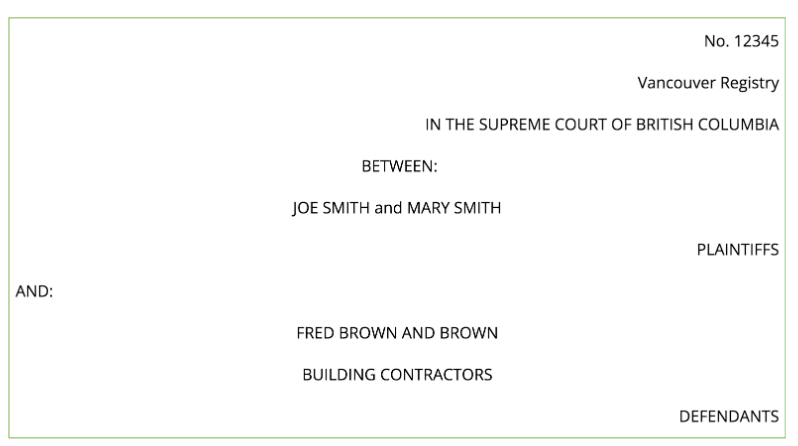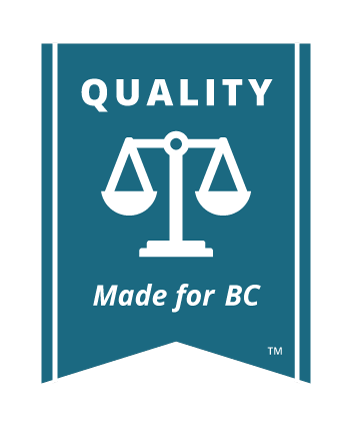Preparing your Documents
Once you have decided on the type of document to use, the parties, and the registry location, it is time to prepare your document. Copies of the documents are included at the end of this guide. You can also get copies from any court registry or download them from the website addresses at the end of this guide.
Style of Proceeding
Begin by preparing a style of proceeding (also often referred to as a “style of cause”).
The style of proceeding is used on documents prepared for the litigation. It provides the key information that will identify your claim: the parties, the court, and the file number.
You will use the style of proceeding on every one of your documents, whether they are filed in the court registry or not. Create it properly once, and you can copy and paste it into new documents as you prepare them.
Here is an example of a completed style of proceeding on a notice of claim.

You will not yet have a file number. Rather, the file number (in the top right hand corner) will be stamped by the court registry when you file your claim.
However, all future documents must include the file number. It is important for the registry to identify the case.
How to Draft a Notice of Civil Claim
A Notice of Civil Claim might be the most important document in the case. It explains what happened, what you would like the Court to do about it, and why.
It may be worth getting a lawyer to help with the Notice of Civil Claim, even if you do not plan on using a lawyer for the rest of the claim.
You should look at Notices of Civil Claim that have been prepared by lawyers in cases like yours before drafting. This will help you understand what you may want to include. After it is filed, unless the Court orders it secret, a Notice of Civil Claim is a public document. You can get copies of Notices of Civil Claim through the registry, and the Courthouse library staff may be able to help you locate helpful examples.
The Notice of Civil Claim has three parts: Statement of Facts, Relief Sought, and Legal Basis.
Statement of Facts – What Happened?
This is your chance to tell the story. Your job is to explain what happened.
When drafting your factual basis section:
- Write in a chronological order
- Use a new paragraph for every sentence, and
- Keep your sentences short
You do not need to explain how you are going to prove what happened. The rule is you need to plead facts, not evidence.
For example, if you sue a store for a slip and fall, the fact that the store’s walkway was covered in ice would be a very important fact. You would want to include that fact in your pleading. However, you would not include that you heard 3 other customers complain about ice. This is just evidence that might help prove that the walkway was slippery. The important fact is whether the walkway was slippery.
The facts that you need to prove in order to establish your claim are called “material facts”. Understanding what are the “material facts” for your claim can be tricky.
To provide an example between a fact and a material fact, in the slippery walkway case referred to above, that there was ice on the walkway is a material fact. That you were going to the store to buy toothpaste is not a material fact. Though it may come out in trial as you tell your story, it is not something that you have to prove to establish your case. If you were going to buy detergent and slipped and fell, what you want the Court to do, and why would not change? Therefore, why you went to the store is not a material fact.
In thinking about what material facts to include, think about what you want the Court to order, and the legal basis that will allow them to make that order.
You can find help with deciding what needs to go into your claim at the local courthouse library. One helpful resource available at the Courthouse is a book called “McLachlin & Taylor BC Practice”. This book has examples of what you need to include in your Notice of Civil Claim to prove different claims in court and has the exact text you need to include.
Relief Sought – What Should the Court Do About It?
The second part of the claim is where you set out what you would like the Court to do about the facts you have described. Do you want money? Do you want an order that the defendant stops doing what you are complaining of? Do you want both?
Money: If you would like money, you need to include a claim for “damages”. Damages in law simply mean money to compensate you for a loss.
The law recognizes different types of damages.
- General Damages: Also called “non-pecuniary” damages. This is money to compensate for a loss that is not easily given a dollar amount. For example, pain and suffering, or loss of ability to do something, can lead to an award of general damages
- Special Damages: Also referred to as “pecuniary” damages. This is money to compensate for a specific loss. For example, if you have already had to pay medical bills, these bills might be claimed as “special damages”
- Aggravated Damages: This is money aimed to compensate for extra injury caused by how a wrongful act is done. For example, they could provide some compensation for hurt feelings arising from a cruel wrongful dismissal
- Punitive Damages: Punitive damages are not aimed at compensating for any loss suffered, but are aimed at punishing the wrongdoer
The Defendant to do, or stop doing, something: If you would like and order the defendant(s) to have to do, or stop doing, something, then you have to make a claim for an injunction.

Key Terms
Injunction: An injunction is an order given by the Court requiring that something be done (called a mandatory injunction) or not done (called a prohibitory injunction).
Costs: “Costs” are amounts of money that the Court awards to someone who has succeeded in litigation to cover some of their expenses. Ordinarily a claim for costs is included in almost every notice of civil claim. See Costs.
Legal Basis – Why Can the Court Help?
The legal basis is where you set out the law. You need to say what law that allows the Court to give you the relief you are asking for.
Determining the law that applies to your case is hard. Learning to decide what law applies where is a large part of what is taught in law school. There are many helpful resources at the Courthouse libraries that may assist. However, getting up to speed on what law applies will take time and effort.
For more information on researching the law applicable to your case, see The Law.







 JusticeEducation.ca
JusticeEducation.ca JusticeEd
JusticeEd /JusticeEducation
/JusticeEducation